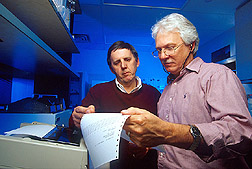This page has been archived and is being provided for reference purposes only. The page is no longer being updated, and therefore, links on the page may be invalid.
Read: more details in Agricultural Research. | Collaboration Aids Moroccan, American Livestock ProducersBy Kathryn Barry StelljesApril 10, 2001 Tests developed by Agricultural Research Service scientists to diagnose two serious tickborne diseases in livestock--anaplasmosis and babesiosis--are giving Moroccan researchers an accurate picture of the disease situation in that country. The information gathered will also help American officials protect domestic livestock from the diseases by facilitating standardization of the tests worldwide. Researchers at ARS’ Animal Disease Research Unit in Pullman, Wash., trained Moroccan scientists to use these tests in conjunction with the existing test for another disease, theileriosis (ty-leer-ee-osis). Morocco has 28 million sheep, goats, cattle, donkeys and horses. But until now, officials have had no way to determine the prevalence and impact of these diseases on Moroccan livestock. The team collected blood samples and ticks from cattle, horses and donkeys at 26 sites throughout the country. The tests confirmed the presence of each disease-causing organism, including the first verification in Morocco of anaplasmosis in cattle. Theileriosis proved to be the most prevalent tickborne disease in cattle. And nearly two-thirds of the donkeys and horses tested were found with equine babesiosis, also known as piroplasmosis. The next phase of the research will focus on the ticks that transmit the diseases. Three tick species were identified as the likely carriers, but additional molecular work is necessary to confirm the role of each tick. An article describing this research appears in the April issue of Agricultural Research, ARS' monthly magazine. ARS is the chief scientific research agency of the U.S. Department of Agriculture. Scientific contacts: Willard L. Goff and Donald P. Knowles, ARS Animal Disease Research Unit, Pullman, Wash., phone (509) 335-6029, wgoff@vetmed.wsu.edu, dknowles@vetmed.wsu.edu. |

